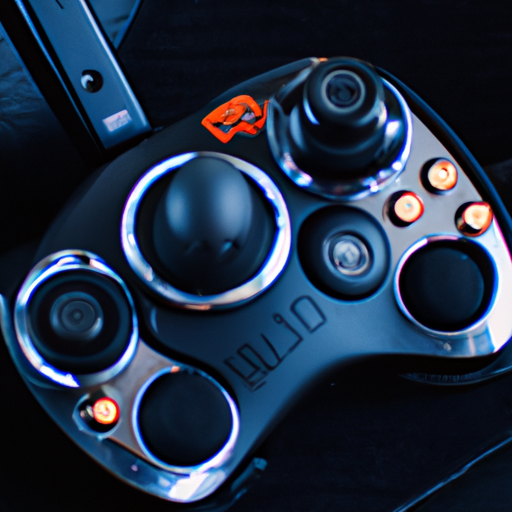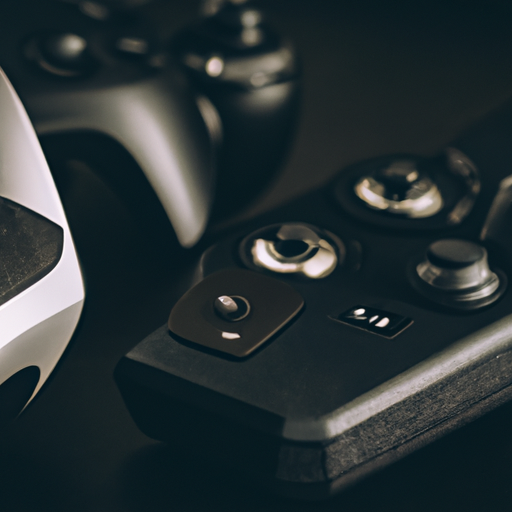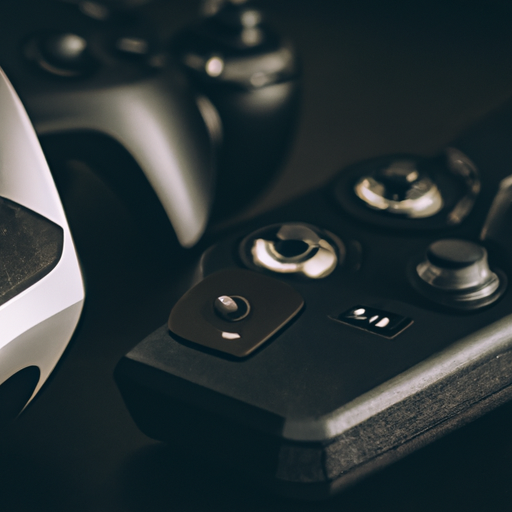So you’ve gotten yourself a shiny new drone, but now you’re faced with the exciting yet overwhelming task of finding the perfect controller for your aerial adventures. With a multitude of options available in the market, it can be quite a challenge to determine which drone controller is truly the best fit for you. Fret not, as we’ll explore the diverse range of drone controllers out there, highlighting their features, functionalities, and compatibility to help you make an informed decision. Get ready to take your drone piloting skills to new heights! When it comes to flying your drone, the controller you choose can greatly impact your overall experience. There are several types of drone controllers available on the market, each with its own unique features and capabilities. In this article, we will explore the different types of drone controllers, discuss the features you should consider when making a choice, and compare some popular options to help you make an informed decision.

Types of Drone Controllers
Standard Radio Controller
The standard radio controller is the most traditional and widely used type of drone controller. It consists of a handheld device with joysticks and various buttons to control the drone’s movement, camera, and other functions. This type of controller offers a tactile and precise control experience and is favored by many professional drone operators.
Smartphone App Controller
The smartphone app controller utilizes your smartphone as the main control interface for the drone. By downloading a drone-specific app on your smartphone, you can connect to the drone and control its movements through virtual joysticks displayed on the screen. This type of controller is convenient as it eliminates the need for an additional physical controller, but it may not provide the same level of responsiveness and precision as a traditional controller.
Gamepad Controller
For gamers or those familiar with console gaming, a gamepad controller may be an attractive option. These controllers resemble the ones used for gaming consoles and offer a familiar and intuitive control experience. They often feature a more ergonomic design and additional buttons to map various drone functions. Gamepad controllers can be connected to your smartphone or directly to the drone, depending on the model.
Motion Controller
Motion controllers are the latest innovation in drone control technology. These controllers utilize motion sensing technologies, such as gyroscopes and accelerometers, to interpret your hand movements and translate them into drone commands. By simply tilting, rotating, or waving the controller, you can control the drone’s movements and even perform advanced flight maneuvers. Motion controllers offer a unique and immersive control experience but may require some practice to master.
Features to Consider
When choosing a drone controller, there are several features you should consider to ensure it meets your specific needs and preferences.
Compatibility with Drone
Before purchasing a drone controller, it is crucial to check its compatibility with your drone model. Not all controllers work with every drone, so make sure to research and confirm if the controller you are interested in is compatible with your drone.
Range and Signal Strength
The range and signal strength of a controller determine how far you can fly your drone while maintaining a stable and responsive connection. If you plan on flying your drone over long distances or in areas with potential signal interferences, consider controllers with longer range and stronger signal capabilities.
Ergonomics and Comfort
Since you’ll be holding and operating the controller for extended periods, it is essential to consider its ergonomics and comfort. Look for controllers that have a comfortable grip, well-placed buttons and joysticks, and an overall design that suits your hand size and shape.
Ease of Use
The ease of use of a controller can greatly affect your flying experience, especially if you are a beginner. Controllers with intuitive layouts and clearly labeled buttons can make it easier for you to learn and navigate different functions. Additionally, controllers with user-friendly interfaces and straightforward setup processes can contribute to a seamless experience.
Customization Options
Depending on your flying style and preferences, having customization options on your controller can be beneficial. Look for controllers that allow you to customize button mappings, adjust sensitivity settings, and even program specific flight patterns. These features can enhance your control precision and tailor the drone’s behavior to your liking.
Dual Control Mode
Some advanced controllers offer a dual control mode, which allows multiple users to operate the drone simultaneously. This can be particularly useful for training sessions or collaborative aerial photography and videography. If you plan on flying with a partner or sharing your drone with others, consider controllers that support dual control functionality.
Popular Drone Controllers
Now that we have discussed the different types of drone controllers and the features to consider, let’s take a look at some popular options available on the market.
DJI Phantom 4 Controller
The DJI Phantom 4 controller is a standard radio controller designed specifically for the DJI Phantom 4 series drones. It features a sleek and ergonomic design with customizable buttons and a built-in touchscreen display for live video feed and flight information. The controller offers precise control and supports a wide range of intelligent flight modes and camera operations.
Yuneec ST16S Controller
The Yuneec ST16S controller is another popular choice among drone enthusiasts. It is a high-performance controller with an integrated 7-inch touchscreen display, making it easy to access and control various functions. The ST16S controller offers seamless compatibility with Yuneec drones and provides an immersive control experience with its smooth joysticks and customizable button mapping.
Skydio 2 Controller
The Skydio 2 controller is designed specifically for the Skydio 2 drone, known for its advanced obstacle avoidance capabilities. The controller features a compact design with an integrated smartphone holder, allowing you to easily mount your smartphone for a seamless control interface. It offers precise control, gesture-based commands, and compatibility with the Skydio Autonomy Engine for autonomous flight capabilities.
Autel Robotics Evo Controller
The Autel Robotics Evo controller is a feature-packed option for Autel drones. It boasts a built-in OLED screen, ergonomic design, and customizable buttons and joysticks. The controller supports a wide range of flight modes and camera settings, allowing you to capture stunning aerial shots with ease.
Parrot Skycontroller 3
Parrot Skycontroller 3 is a smartphone app controller designed for Parrot’s ANAFI drones. By connecting your smartphone to the controller, you can access advanced flight features and camera controls through the dedicated app. The Skycontroller 3 offers a compact and lightweight design, making it portable and easy to carry during your drone adventures.
FPV Goggles with Controller
For an immersive flying experience, FPV (First Person View) goggles combined with a controller can take your drone flying to a whole new level. These goggles allow you to see a live video feed from your drone’s camera, giving you a real-time perspective as if you were inside the cockpit. Paired with a compatible controller, you can control the drone’s movements while experiencing the thrill of aerial navigation.
Comparison of Drone Controllers
Now that we have explored the different drone controllers and their features, let’s compare them in terms of key aspects that are crucial when selecting the right controller for your needs.
Overview of Key Features
When comparing drone controllers, it is essential to consider their key features. Take note of the available control options, the presence of additional buttons for custom mappings, the presence of a built-in display, and any unique functionalities that may set a particular controller apart from others.
Performance and Responsiveness
The performance and responsiveness of a drone controller greatly impact the flight experience. Controllers with low latency and high precision control signals can provide a more accurate and smooth flying experience. Look for controllers that offer advanced control algorithms to maximize responsiveness and minimize input lag.
Battery Life
Battery life is an important factor to consider, especially if you plan on flying your drone for extended periods. Controllers with longer battery life can ensure that you have sufficient power to operate the drone and make adjustments without interruption. Consider controllers that offer removable or rechargeable batteries for convenience.
Build Quality and Durability
Since drone flying often involves outdoor activities, it is crucial to have a controller that can withstand different weather conditions and rugged handling. Look for controllers made from durable materials and featuring water-resistant or splash-proof designs. Additionally, controllers that offer protective cases or storage bags can provide additional safeguarding during transport.
Compatibility with Third-Party Apps
If you intend to expand your drone’s capabilities by using third-party apps, make sure to check for controller compatibility. Some controllers have built-in support for popular third-party apps, allowing you to unlock advanced features and enhance your overall flying experience.
Price and Value for Money
The price of a drone controller can vary significantly depending on its features and capabilities. Consider your budget and weigh the features offered by each controller to determine the best value for your money. Remember that the most expensive controller may not always be the best fit for your specific needs.

Pros and Cons of Different Controllers
Let’s now explore the pros and cons of each type of drone controller to help you understand their strengths and limitations.
Standard Radio Controller
Pros:
- Offers precise and tactile control.
- Widely supported by various drone models.
- Often features customizable buttons and joysticks.
- Suitable for professional drone operators seeking maximum control.
Cons:
- May have a steeper learning curve for beginners.
- Bulkier and less compact compared to other options.
- Requires an additional physical controller to carry.
Smartphone App Controller
Pros:
- Convenient and eliminates the need for an additional physical controller.
- Often provides a familiar touchscreen interface.
- Can offer additional features through smartphone apps.
- Generally more affordable compared to traditional controllers.
Cons:
- May not provide the same level of responsiveness or precision as physical controllers.
- Relies on the battery life of your smartphone.
- Difficult to use in bright sunlight or with gloves on.
Gamepad Controller
Pros:
- Familiar and intuitive control experience for gamers.
- Often features customizable buttons and ergonomic designs.
- Can be connected directly to the drone or through a smartphone.
- Suitable for those who prefer a more compact and portable option.
Cons:
- Limited compatibility with certain drone models.
- May lack some advanced control functions compared to standard radio controllers.
- Setup and pairing process can be more complex.
Motion Controller
Pros:
- Offers a unique and immersive control experience.
- Can perform precise maneuvers by translating hand movements to drone commands.
- Suitable for those seeking a futuristic and interactive control experience.
- Can be more intuitive and easier to learn for beginners.
Cons:
- May require practice to master the motion gestures and achieve precise control.
- Limited compatibility options compared to traditional controllers.
- Not suited for users with motion-related limitations or discomfort.
Top Factors Influencing Controller Choice
When selecting the right drone controller, there are several factors that you should keep in mind, as they can greatly influence your choice.
Type of Drone and Purpose
Consider the type of drone you own or plan on purchasing, as not all controllers are compatible with every drone model. Additionally, think about your intended purpose for flying the drone. If you are an aerial photographer or videographer, you may prioritize controller features that allow versatile camera control.
User Experience Level
Your experience level as a drone operator can also play a role in choosing the right controller. Beginners may prefer controllers with simpler interfaces and user-friendly setups, while more experienced operators may require advanced control options and customization capabilities.
Budget and Cost
Your budget is another key factor to consider. Drone controllers can range in price from affordable options to more premium controllers with advanced features. Determine your budget beforehand and find a controller that offers the best value for your money and fits within your financial constraints.
Choosing the Right Drone Controller
After considering all the different aspects and options, it’s time to make a decision and choose the right drone controller for your needs. Here are some steps to guide you in the selection process:
Evaluate Compatibility and Connectivity
Ensure that the controller you are interested in is compatible with your specific drone model. Check the manufacturer’s website or contact customer support if necessary. Additionally, consider the connectivity options available and choose a controller that suits your preferred method of connection (e.g., direct connection, smartphone app).
Consider Controller Ergonomics and Comfort
Visit a local store or read user reviews to get an idea of how a controller feels in your hand. Look for controllers that have ergonomic designs and comfortable grips for extended use. Take into account factors such as button placement and overall weight to ensure a comfortable and fatigue-free flying experience.
Assess the Control Range and Signal Strength
Determine the control range and signal strength of the controllers you are considering. If you plan on flying your drone over long distances or in areas with potential signal interferences, prioritize controllers with extended range and reliable signal capabilities. Check the manufacturer’s specifications for accurate range estimations.
Examine Ease of Use and Customization
Consider how easy the controller is to set up and operate. Read user reviews or watch video tutorials to get an idea of the user experience. Opt for controllers with intuitive layouts, clearly labeled buttons, and user-friendly interfaces. Additionally, assess the customization options available, such as button mapping and sensitivity adjustments.
Look for Dual Control Mode
If you plan on flying with a partner or sharing your drone with others, consider controllers that offer dual control mode functionality. This feature allows multiple users to operate the drone simultaneously, providing a collaborative and interactive flying experience. Check if the controller you are interested in supports dual control mode.
Compare Prices and Value for Money
Compare the prices of the different controllers you have shortlisted and weigh their features and capabilities against the price. Determine which controller offers the best value for your money based on your budget and specific requirements. Remember not to solely focus on the price; consider the overall quality, reliability, and user reviews of each controller.
Conclusion
In conclusion, choosing the best drone controller for your needs requires careful consideration of various factors. By evaluating compatibility, control range, ergonomics, ease of use, customization options, and price, you can make an informed decision. Remember that personal preferences and individual flying styles will ultimately influence the controller choice. It is essential to try and test different controllers whenever possible to get a hands-on experience and understand how they fit your specific preferences and requirements. As technology advances, we can expect more exciting developments and innovations in drone controller technology, enhancing the overall flying experience and opening up new possibilities for drone enthusiasts.



